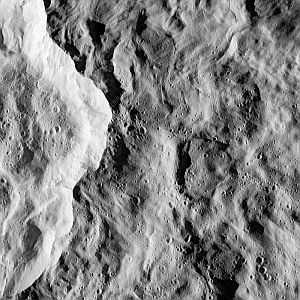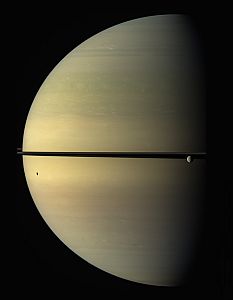
FŘr eine deutsche ▄bersetzung dieser Seite einfach die Brandenburger Flagge anklicken
 |
Click the Brandenburg Flag for a German translation FŘr eine deutsche ▄bersetzung dieser Seite einfach die Brandenburger Flagge anklicken |


|
|
RheaA collection of pictures of Saturn's moon Rhea
|
|



|
Rhea is Saturn's second largest
moon. It is an icy world that was first visited during the flyby of Voyager 1. With five close flybys between 2005 and 2013, Cassini enhanced our knowledge of the moon and delivered some amazing pictures. Here are our favorites. Like our other space galleries, the pictures have not been selected because of their scientific significance but because of their esthetic value and sometimes because of their historical importance.
Mosaic of 21 images taken by Cassini on Nov. 26, 2005 from 49,206 to 36,466 miles (79,190 to 58,686 km) |

|
Rhea was discovered on December 23, 1672 by
Giovanni Cassini. After Titan and Iapetus, it was third discovery of a
moon of Saturn. On November 12, 1980, during its passage of the Saturn system, Voyager 1 passed Rhea at a distance of 36,700 miles (59,000 km). The probe took a number of images during the passage over Rhea's high northern latitudes. Some of the closeup pictures were assembled into a mosaic that represented one of the best image of any moon of Saturn at the time. |
  Mosaic of 10 images taken at a range of 75,000-85,000 km. Source: NASA / Bj÷rn Jˇnsson |
  Artist's concept of Voyager 1 passing Saturn and Rhea Source: universesandbox.com
|

  Saturn facing hemisphere from 447,000 miles (720,000 km) Source: NASA |
  High resolution image from 79,500 miles (128,000 km). Source: NASA/JPL |
  High resolution image from 17,108 miles (82,599). Source: NASA |

|
On July 1, 2004, the CassiniľHuygens probe, a collaboration between NASA, ESA, and
the Italian Space Agency, was inserted into Saturn's orbit. On November 26, 2005, the probe performed the first close approach of Rhea, passing the moon at 311 miles (500 km). Four more close approaches were done between 2007 and 2013. On January 11, 2011, Cassini got as close as 42.9 miles (69 km) to Rhea's surface, taking pictures of unprecedented resolution.
X |
  |

  Surface from 2,280 miles (3,670 km) March 9, 2013 Source: NASA / JPL |
  Surface from 317.5 miles (511 km) November 26, 2005 Source: NASA / JPL / sciencephoto.com |
  Surface from 124 miles (200 km) January 11, 2011 Source: NASA / JPL / astronomy.com |

|
The pictures above are some examples of high resolution closeup shots obtained during the close flybys. Click
Here to see NASA's image gallery of the flybys. Throughout the years, Cassini also took a number of pictures of Rhea from a distance, providing an insight into the interactions of the various bodies of the Saturn system. (below). |

  Rhea in front of Titan June 16, 2011 Source: NASA / JPL |
  Rhea's surface with Dione and Saturn's rings in the back January 11, 2011 Source: NASA / Planetary Society |
  Rhea behind Saturn's rings July 1, 2006 Source: NASA / i.pinimg.com |

 |

|
|
Enceladus above and Rhea below Saturn's rings December 19, 2016 Source: NASA / newatlas.com |
Rhea in front of Saturn November 4, 2009 Source: NASA / friendsofnasa.org |

|
Today, thanks to the Cassini images, there are over 100 named surface features on Rhea, most of them impact craters. The pictures right are focused on two of the largest craters, Inktomi and Tirawa. In 2014, ten years of images resulted in a complete map of Rhea (below). |
  Crater Inktomi (center of picture) February 24, 2006 Source: NASA / JPL / Wikipedia
|
  Crater Tirawa (southeast of center) December 17, 2007 Source: NASA / JPL / Wikipedia
|

  Global 3-Color map of Rhea, generated by Dr. Paul Schenk from Cassini images taken between 2004 and 2014; Source: Wikipedia.  
 

|